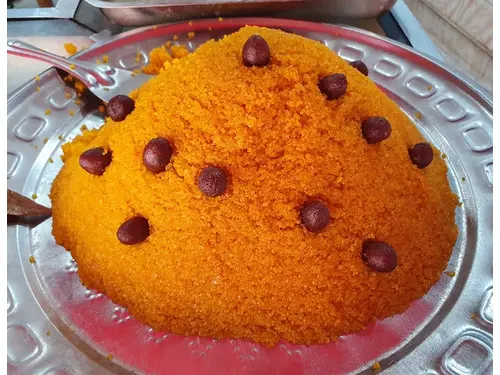
Mihidana: The Delicate Bengali Sweet You Must Try
Introduction
If you are a fan of Bengali sweets, then Mihidana is a dessert you cannot miss. Known for its delicate, golden granules that melt in your mouth, Mihidana is often described as the “micro version of Boondi.” This iconic sweet originates from Burdwan, West Bengal, and is crafted from a combination of gram flour, saffron, and sugar syrup. Its unique taste and intricate preparation have earned it a Geographical Indication (GI) tag, making it one of Bengal’s most celebrated confections.
In this blog, we will explore the fascinating history of Mihidana, its traditional preparation methods, and how you can make this delightful sweet at home.
The History and Cultural Significance of Mihidana
Mihidana has a rich history that dates back to 1904, when it was first created in Burdwan by Bhairav Chandra Nag, a legendary sweet maker. The sweet was specially prepared for Lord Curzon, the Viceroy of India, during his visit to Bengal. Curzon was so captivated by its exquisite taste that Mihidana quickly gained popularity as a royal delicacy.
Over the years, Mihidana has transcended its royal origins and become a beloved sweet across Bengal and beyond. Its unique texture, flavor, and aroma have made it a favorite at weddings, festive celebrations, and special occasions. The sweet’s global recognition led to its GI certification, ensuring that only sweets made in Burdwan can officially be called “Burdwan Mihidana.” This certification not only preserves its authenticity but also celebrates its cultural heritage.
Mihidana holds a special place in the hearts of Bengali sweet lovers. Unlike other sweets that are larger or denser, Mihidana captivates with its delicate, tiny grains that dissolve effortlessly on the tongue, offering a burst of sweetness and a hint of saffron aroma.
What Makes Mihidana Unique?
The name “Mihidana” itself explains its defining feature. It comes from two Bengali words:
-
“Mihi” meaning fine
-
“Dana” meaning grains
This perfectly describes the sweet’s characteristic tiny, crisp granules. Unlike conventional sweets, Mihidana requires precise preparation and careful handling to maintain its signature texture. Each step, from batter preparation to frying and soaking in sugar syrup, is crucial to achieving the perfect balance of crunch and melt-in-the-mouth softness.
Ingredients You’ll Need
To make authentic Mihidana at home, you will need the following ingredients:
-
1 cup Besan (gram flour)
-
2 tbsp Rice flour
-
1 pinch Baking soda
-
1 tbsp Ghee (clarified butter)
-
½ cup Water (for batter)
-
1 cup Sugar
-
½ cup Water (for syrup)
-
Saffron strands (optional)
-
Cardamom powder
These simple ingredients come together to create a dessert that is anything but ordinary. The combination of gram flour and rice flour gives Mihidana its crisp texture, while saffron and cardamom enhance the flavor and aroma, making it a truly aromatic treat.
Step-by-Step Preparation of Mihidana
Step 1: Prepare the Batter
Start by mixing the besan, rice flour, baking soda, and ghee in a bowl. Gradually add water while stirring continuously to form a thin, flowing batter. The consistency is important: too thick, and the droplets won’t form properly; too thin, and they will spread excessively while frying.
Step 2: Fry the Granules
Heat ghee in a deep pan on medium heat. Pour the batter through a perforated ladle, locally called a jharna, to create tiny, uniform droplets. Fry these granules until they turn golden brown and crisp. Frying requires attention, as the small grains can cook quickly. Once fried, remove them carefully and drain any excess oil.
Step 3: Prepare the Sugar Syrup
While the granules cool slightly, prepare the sugar syrup. Boil sugar and water until the syrup reaches a one-string consistency. Add saffron strands and a pinch of cardamom powder to the syrup for added fragrance and flavor.
Step 4: Soak the Mihidana
Once the syrup is ready, add the fried granules into the warm syrup. Allow them to soak for a few minutes. The tiny grains absorb the syrup perfectly, resulting in a sweet, aromatic, and melt-in-the-mouth texture. Mihidana is now ready to serve.
How to Enjoy Mihidana
Mihidana is versatile and can be enjoyed in several ways:
-
With Rabri: Pour thick, creamy rabri over the soaked granules for an indulgent treat. The combination of crisp grains and creamy rabri creates a luxurious dessert experience.
-
As a Dry Sweet: Enjoy it on its own, similar to Boondi, as a crunchy and aromatic snack.
-
Mihidana Ladoo: Shape the soaked granules into small ladoos for festivals and special occasions. This variation is particularly popular during weddings and traditional ceremonies.
Each method brings out a slightly different texture and flavor, making Mihidana a dessert that can be adapted to various tastes and occasions.
Tips for Perfect Mihidana
-
Consistency is Key: Ensure the batter flows smoothly but is not too watery to form proper granules.
-
Frying Temperature: Fry on medium heat for uniform golden color and crispiness.
-
Sugar Syrup: Prepare syrup just before frying to ensure the granules soak evenly.
-
Storage: Store in an airtight container if you are not serving immediately; it retains freshness for several days.
With these tips, even home cooks can create Mihidana that closely resembles the authentic Burdwan version.
Conclusion
Mihidana is not just a sweet; it is a testament to the rich culinary heritage of Bengal. From its royal origins in Burdwan to its status as a Geographical Indication-certified delicacy, this dessert continues to capture the hearts of sweet lovers worldwide. Its delicate texture, fragrant aroma, and melt-in-the-mouth taste make it truly unforgettable.
Whether you choose to enjoy it with creamy rabri, savor it dry, or shape it into festive ladoos, Mihidana offers a delightful taste of Bengal’s rich tradition. Making it at home can be a fun and rewarding experience, allowing you to connect with a century-old culinary legacy.
So, the next time you crave a Bengali sweet, try Mihidana. Its golden grains, subtle saffron aroma, and perfect sweetness promise to delight your taste buds and leave you yearning for more.


